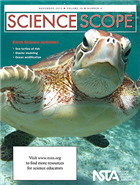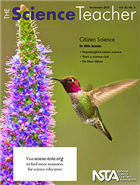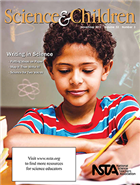Ideas and info from NSTA's November K-12 journals
By Mary Bigelow
Posted on 2015-11-08
Each of the K-12 journals this month includes Three-Dimensional Instruction: Using a New Type of Teaching in the Science Classroom with suggestions on how to integrate Disciplinary Core Ideas, Science and Engineering Practices, and CroEarath ss-Cutting Concepts into our teaching. “None of the dimensions can be used in isolation; they work together so that students can build a deeper understanding as they grapple with making sense of a phenomenon or finding solutions to problems.” A must read!
 Science Scope – Earth Science Activities
Science Scope – Earth Science Activities
It’s not hard to get middle school students into the Earth Sciences, making connections with the topics and their own lives! Each featured article this month has a full-page description of how the lesson aligns with the NGSS middle school standards.
- Troubling Tides: Will Sea Turtles Survive the Rising Seas?–This 3-part activity helps students learn the concepts of critical habitat and the effects of changing sea level through modeling and data analysis.
- There’s a Glacier in Your Backyard: Modeling Glaciers Through Active Learning and Modeling the Physical Properties of Glaciers both have students make and use physical models of glaciers to explore how glaciers move, erode, and deposit materials.
- The Ocean Platform Engineering Design Challenge: Flooded With Stem Content and Practices — Students explore forces that affect objects in the oceans as they design and build a structure that can withstand these forces and draw conclusions about design constraints.
- Astrobiobound: Tying Science and Engineering Design Together — In this 5E lesson, students take on the role of scientists to decide what evidence would support the presence of life on other planets and what engineering design would be necessary to get the evidence.
- Exploring the Complexity of Ocean Acidification: An Ecosystem Comparison of Coastal pH Variability — Students analyze data to explore the variability of pH levels in coastal marine ecosystems in this 5E lesson, which includes See-Think-Wonder in the Engage step.
- Tried and True: Volcano! Investigating Plate Tectonics, Geologic Time, and the Rock Cycle — Here’s how to go beyond the baking soda/vinegar to a more in-depth understanding of the processes.
- Teacher’s Toolkit: Scaffolding Students Toward Argumentation — This article has four levels for guiding students to an understanding of argumentation.
The November issue of The Science Teacher has a Safety Acknowledgment Form for Earth Science.
Here are some SciLinks with content information and suggestions for additional activities and investigations related to this month’s featured articles: Acid Water, Astrobiology, Geologic Time, Glaciers, Hot Spots/Volcanoes, Life on Other Planets, Ocean Currents, Ocean Waves, Polar Climates, Polar Marine Ecosystems, Plate Tectonics, Properties of Ocean Water, Reptiles, Rock Cycle, Space Exploration, Volcanic Eruptions, Volcanic Features.
Continue for The Science Teacher and Science and Children.
 The Science Teacher — Citizen Science
The Science Teacher — Citizen Science
“Citizen science harnesses the power of people [including students] by crowdsourcing data collection and analysis.” 21st-Century Citizen Science provides a rationale for this type of global awareness and interactions, as students engage in authentic research. (Career of the Month: Citizen Scientist (and Research Chemist) describes how a chemist became a butterfly advocate.)
- Hummingbird Citizen Science — Students collect, organize, and analyze data on hummingbird feeding and other behaviors, contributing the local data to a large-scale project. There are suggestions on how this type of project can be integrated with general biology and connect to the NGSS.
- Start a Science Club — Establish a science club that engages students through partnerships with local organizations and a service-learning
component. - Sewing Up Science — Students explore electronic circuitry and create new products with e-textiles.
- No Blue Ribbon – The authors provide 5 critiques of traditional science fairs and 2 suggestions for alternatives that engage students in citizen science and engineering design.
- The Green Room: Keeping Soils Fertile — Increase students’ awareness of the science behind the “Green Revolution.”
Here are some SciLinks with content information and suggestions for additional activities and investigations related to this month’s featured articles: Characteristics of Birds, Compost, Electronic Circuits, Pollination, Science Fair, Soil Conservation, Sustainable Agriculture.
 Science and Children — Writing in Science
Science and Children — Writing in Science
“Science and engineering include specialized ways of talking and writing,” and learning how to communicate the findings of investigations and the results of design projects is essential. As the article in this issue demonstrate, it’s never to early to get children thinking and communicating as scientists or engineers.
- Putting Ideas on Paper — Using the Claim-Evidence-Reasoning framework, students make predictions, explore and observe, create data charts, and write scientific explanations.
- Poetry Rocks! and Science for Two Voices — Students use poetry to process and share their observations.
- Map It Then Write It — Here are several examples of graphic organizers to help students organize their thoughts during the writing process. These are also appropriate for older students!
- Programming Digital Stories and How-To Animations and Engineering Encounters: Sailing Into the Digital Era — Students use engineering design to develop their own digital stories and e-books, including storyboards and testing/revision.
- Teaching Through Trade Books: That Was Then, This Is Now — With these two 5E lessons suggested trade books, students compare and contrast how engineering design has changed over the years, using toys and whale watching as the context.
- The Early Years: Documenting Discoveries — Students engage in long-term observations and data collection while caring for living things in the classroom.
- Formative Assessment Probes: Constructing Cl-Ev-R Explanations to Formative Assessment Probes —
- Engineering Encounters: Sailing Into the Digital Era —
- Methods and Strategies: Deep Assessment — Assessing student writing focuses on science content, inquiry, and vocabulary. The article describes these and provides a sample rubric.
Here are some SciLinks with content information and suggestions for additional activities and investigations related to this month’s featured articles: Composting, Invertebrates, Light and Color, Rocks, Sound, States of Matter, Whales, Worms.
Disclaimer: The views expressed in this blog post are those of the author(s) and do not necessarily reflect the official position of the National Science Teaching Association (NSTA).


